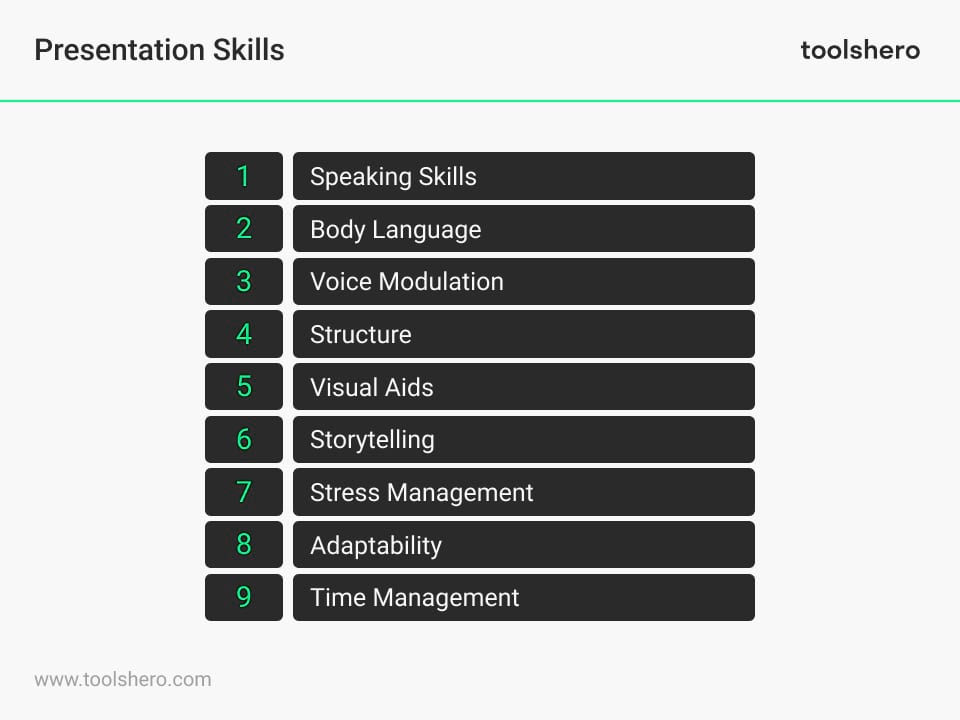Presentation Skills explained plus examples

Presentation skills: this article explains the topic of presentation skills in a practical way. The article starts with reasons why these skills are important in the business environment and in academic research, followed by examples and practical tips. Enjoy reading!
What are presentation skills?
Whether it concerns presenting the results of a long-term research project or introducing a new invention, a new strategy or a new brand, presentations are often important moments for professionals.
Learning presentation skills helps presenters understand what they need to practice when preparing for such important moments.
Practicing and developing in this area makes them more confident and competent, which can make all the difference.
Examples of presentation skills include:
- Fluency
- Body language
- Use of voice
- Structure
- Visual aids
- Storytelling
- Stress management
- Adaptability
- Time management

Figure 1 – examples of Presentation Skills
These skills are covered in detail later in this article. First you can read how presentations help professionals advance in their careers and why the phenomenon of presentation anxiety does not have to be an obstacle. You then read about the different types of presentations and presentation styles.
Why is giving good presentations an important skill?
It’s no secret that effective presentations can help people advance in their careers. After all, what better way to demonstrate knowledge and expertise than giving a well-thought-out and good presentation? The right skills enable the presenter to share ideas with the general public in an engaging and persuasive way.
In this article you will read about the different types of presentations that are important in professional life and you will read about practical tips to develop yourself into an effective presenter.
Fear of presentations and public speaking
Fear of presentations and speaking in front of an audience is something that many people share.
It is a normal feeling and has to do with dealing with the pressure of conveying information to others, the fear of judgment and the natural fear of the unknown.
Fortunately, this fear can be overcome with practice and techniques, and many successful speakers have gone through this process.
The most important thing is to realize that you are not alone in feeling this fear, and that there are resources and support available to help you cope and thrive in public speaking.
Overcoming fear
Overcoming presentation anxiety starts with understanding where this fear comes from and then addressing its causes. Gaining insight into and control over something starts with understanding, especially the causes. You can then work on these.
The cause of anxiety during presentations and public speaking usually stems from:
- Lack of self confidence
- Lack of control (or feeling not having control) – over the situation, other people (the audience) and our own reactions and feelings
- In some cases, a negative memory or experience from the past
These effects are amplified as the size of the audience increases and possibly also depend on the nature of the audience and the situation.
Presentation Skills the main types of presentations
Persuasive presentations
Persuasive presentations aim to influence the audience to make a specific decision or take action.
Examples:
- A start-up founder convincing an investor to provide funding
- A salesperson who tries to convince customers to buy a product
- A political candidate who tries to convince voters to vote for him
Instructive presentations
Instructive presentations focus on guiding the audience in understanding new policies, procedures, laws, or other complex topics.
Examples:
- An HR manager giving a presentation to instruct new employees on company policies
- A teacher who explains to students how to understand a complex mathematical concept
- A legal expert giving a presentation on recent changes in legislation
Informative presentations
Informative presentations aim to provide the audience with factual information about a specific topic, such as updates, benefits, or new developments.
Examples:
- A company presentation in which the HR manager shares information about a new bonus structure for employees
- A health expert giving a presentation on the benefits of a healthy lifestyle
- A technology expert discussing the latest developments in the industry at a conference
Inspirational presentations
Inspirational presentations are intended to motivate the audience, increase their enthusiasm, or create a sense of pride and belonging.
Examples:
- A TED Talk speaker who encourages the audience to pursue their dreams
- A CEO who shares his vision during a company meeting and inspires employees to commit to the company
- A sports coach who motivates his team before an important match through an inspiring and uplifting speech
Presentation styles: which style suits my purpose?
There are different ways to convey a message in a presentation. Read below about which methods are often used.
Extemporaneous presentations
Extemporaneous presentations are presentations that you give without prior preparation, although you plan them in advance and structure them in your mind.
With this method you do not have a fully written text or notes to fall back on. Instead, you rely on your knowledge and speaking skills to give a presentation on the spot.
Extemporaneous presentations may seem more spontaneous, but they require a good command of the topic and confidence in your speaking skills.
Rehearsed presentations
Rehearsed presentations are presentations that you memorize and recite without relying on notes or visual aids.
This approach requires significant effort and practice to deliver the presentation without errors.
It can be very persuasive if done well and the speaker gives a strong, flowing presentation without hesitation.
Written presentations
Written presentations are presentations in which the speaker uses a fully written script or detailed notes to closely follow the content.
This method provides a high degree of precision and control over the words used, reducing the risk of errors.
It is useful for formal, legal, or technical presentations.
Impromptu presentations
Impromptu presentations are similar to extemporaneous presentations, but they are improvised on the fly without prior planning or preparation.
In impromptu presentations, the speaker must think quickly and respond to an unexpected question or situation. The ability to speak clearly and coherently without preparation is crucial here.
This approach is common in informal conversations, debates, or discussions where the speaker must respond immediately.
How to improve presentation skills
Below you will find tips for improving the key skills associated with giving good presentations.
Fluency
Speaking skills are essential for effective business and academic presentations.
Improve it by practicing regularly and asking for feedback, use visual aids such as slides, master the content thoroughly, master nonverbal communication, and work on voice modulation and intonation.
You can also join speaking clubs or take courses focused on public speaking to refine specific skills. Practice and confidence are crucial for successful presentations.
Body language as a part of presentation skills
Mastering body language is also very important for giving effective presentations in both business and academic research.
Improve this skill by becoming aware of your own body language, paying attention to posture, eye contact and gestures.
For example, practice in front of a mirror. Work on self-confidence and relaxation during presentations.
Also study successful speakers to learn from their body language. Consciously controlling body language increases the impact and persuasiveness of a presentation.
Use of voice
Controlling your voice is crucial for effective presentations. Improve this skill by working on tone, tempo, volume and articulation. Practice varying your voice to convey emotion and meaning.
Recording and listening to feedback is helpful and consider consulting voice coaches or taking speaking courses for improvement. Good voice use can make presentations more interesting and convey the message more clearly to the audience.
Presentation Skills and structure
Improve this skill by creating clear introductions, transitions, and conclusions.
Use a logical sequence, such as problem-situation-solution, to structure the presentation.
Use visual aids such as slides and bullet points to reinforce the structure.
Practice concise and clear communication of the most important points.
A well-structured presentation makes it easier for the audience to understand and remember the message.
Visual aids
Effective use of visual aids can make all the difference in business and academic presentations. Improve this skill by providing simple, clear graphics and relevant images.
Limit text and ensure consistency between the verbal and visual message. Practice timing slides and making eye contact with the audience, not just the screen.
Storytelling and Presentation Skills
Storytelling is crucial for effective presentations.
Improve this skill by creating a clear storyline. Use concrete examples and anecdotes to clarify abstract concepts. Work on voice variation and emotion to make the story more engaging.
Practice telling stories in different contexts to build familiarity. A good story can make the message more memorable and persuasive.
Now it’s your turn
What do you think? Do you recognize the explanation about presentation skills? Have you ever given a presentation where you struggled with anxiety? How did you deal with this then? What tips or techniques can you share for overcoming presentation anxiety? Have you ever attended an inspiring presentation? Can you share this moment with us? What do you think are the most important characteristics of a good presentation? Do you have other tips or comments about this article?
Share your experience and knowledge in the comments box below.
More information
- Bradbury, A. J. (2006). Successful presentation skills (Vol. 111). Kogan Page Publishers.
- Gelula, M. H. (1997). Effective lecture presentation skills. Surgical neurology, 47(2), 201-204.
- Haber, R. J., & Lingard, L. A. (2001). Learning oral presentation skills: a rhetorical analysis with pedagogical and professional implications. Journal of general internal medicine, 16, 308-314.
- Pittenger, K. K., Miller, M. C., & Mott, J. (2004). Using real-world standards to enhance students’ presentation skills. Business Communication Quarterly, 67(3), 327-336.
How to cite this article:
Janse, B. (2023). Presentation Skills. Retrieved [insert date] from Toolshero: https://www.toolshero.com/personal-development/presentation-skills/
Original publication date: 11/06/2023 | Last update: 11/06/2023
Add a link to this page on your website:
<a href=”https://www.toolshero.com/personal-development/presentation-skills/”> Toolshero: Presentation Skills</a>












